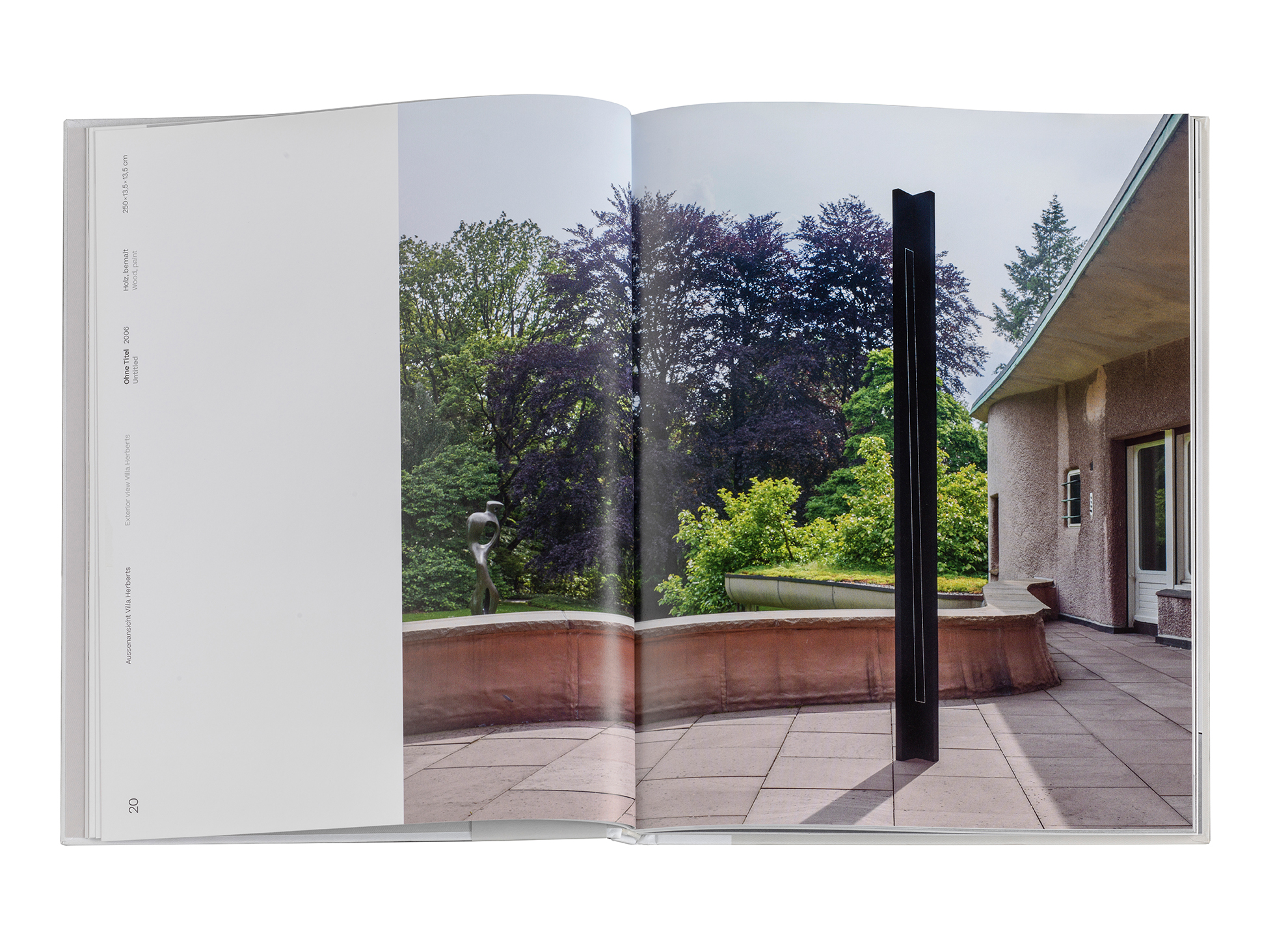Otto Boll. Sculptures / Skulpturen
Otto Boll (Editor), Dierk Dierking (Editor)
The book appears parallel to the exhibition „Otto Boll“ in Skulpturenpark Waldfrieden, Wuppertal. Beside exhibition pictures it documents an overview of the artist's work. To this belongs a selection of pictures from the last 40 years. Reflections about the artist viewing and doing accompany the flow of pictures.
ISBN 978-3-96098-638-6
Price: 28 CHF plus postage

His black lines — circular,
oval or angular — require a quiet,
well-lit background.
Here Otto Boll allows
no compromises.
Robert Rademacher
Admittedly, it needs an attentive eye, for Otto Boll’s sculptures are unobtrusive, hovering discreetly on thin nylon threads. When you’ve discovered them, however, you can’t forget them. Such was my experience in Berlin. This 3½-metre incision in the air, suggesting a slight S-curve, the points tapering so finely that it’s hard to distinguish with the naked eye where the sculpture actually ends — I simply had to have it. Thank goodness, the third of three pieces was still available, and has hung in the entrance hall of our house since 1988.
Here the work has delighted not only us, but also many of our visitors, for over 30 years — with the consequence in some cases that Otto Boll has had to travel to the USA, Switzerland and who knows where else, to hang his hovering aluminium-and-steel sculptures — worked with incredible precision — in the houses of newly-won friends. As a rule, he does this himself, not only because it is quite complicated to hang his sculptures absolutely horizontal, but also because he has very definite ideas as to how and where they should hang. This may also mean that he refuses to hang a sculpture in a given place, if the setting isn’t right. His black lines — circular, oval or angular — require a quiet, well-lit background. Here Otto Boll allows no compromises.
Since about two years ago, Otto Boll has substantially expanded the range of his works. He now creates also “standing” sculptures — although “stand” is actually the wrong term for these delicate structures. Their subtle, rhythmic elegance gives the impression that they are hovering just above their base. If his hanging sculptures were suitable only for interiors, now these “erect” works allow him access to outdoor spaces.
Given the immeasurable diversity of form and dimension available to Otto Boll for his distinctive sculptures, we may expect many more wonderful works from this magnificent artist.
Robert Rademacher, Cologne, June 2019
Otto Boll. Sculptures / Skulpturen
Otto Boll (Editor), Dierk Dierking (Editor)

The book appears parallel to the exhibition „Otto Boll“ in Skulpturenpark Waldfrieden, Wuppertal. Beside exhibition pictures it documents an overview of the artist's work. To this belongs a selection of pictures from the last 40 years. Reflections about the artist viewing and doing accompany the flow of pictures.
ISBN 978-3-96098-638-6
Price: 28 CHF plus postage
His black lines — circular,
oval or angular — require a quiet,
well-lit background.
Here Otto Boll allows
no compromises.
Robert Rademacher
Admittedly, it needs an attentive eye, for Otto Boll’s sculptures are unobtrusive, hovering discreetly on thin nylon threads. When you’ve discovered them, however, you can’t forget them. Such was my experience in Berlin. This 3½-metre incision in the air, suggesting a slight S-curve, the points tapering so finely that it’s hard to distinguish with the naked eye where the sculpture actually ends — I simply had to have it. Thank goodness, the third of three pieces was still available, and has hung in the entrance hall of our house since 1988.
Here the work has delighted not only us, but also many of our visitors, for over 30 years — with the consequence in some cases that Otto Boll has had to travel to the USA, Switzerland and who knows where else, to hang his hovering aluminium-and-steel sculptures — worked with incredible precision — in the houses of newly-won friends. As a rule, he does this himself, not only because it is quite complicated to hang his sculptures absolutely horizontal, but also because he has very definite ideas as to how and where they should hang. This may also mean that he refuses to hang a sculpture in a given place, if the setting isn’t right. His black lines — circular, oval or angular — require a quiet, well-lit background. Here Otto Boll allows no compromises.
Since about two years ago, Otto Boll has substantially expanded the range of his works. He now creates also “standing” sculptures — although “stand” is actually the wrong term for these delicate structures. Their subtle, rhythmic elegance gives the impression that they are hovering just above their base. If his hanging sculptures were suitable only for interiors, now these “erect” works allow him access to outdoor spaces.
Given the immeasurable diversity of form and dimension available to Otto Boll for his distinctive sculptures, we may expect many more wonderful works from this magnificent artist.
Robert Rademacher, Cologne, June 2019
IMPRINT
© DIERKING 2025








